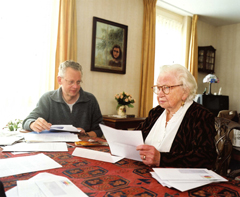|
Biography

Miep en Paul Gies. Foto: Bettina Flitner.Good fortune is like a red thread running throughout my mother's life', remarked Paul Gies, son of Miep and Jan Gies. That remark seems justified, considering how this small, ailing girl, born in Vienna in 1909 and undernourished during the First World War, is now, in 2008, in reasonably good health, still living independently with some assistance, and hoping to celebrate her hundredth birthday in February 2009.
During the German occupation of the Netherlands, Miep Gies was one of those helping the eight people in hiding in the Secret Annex at Prinsengracht 263 in Amsterdam. Her commitment, concern and decisiveness, and perhaps a good dose of luck, helped keep the lives of eight Jewish people out of sight of the German occupiers, and helped keep life bearable for them, despite all the restrictions.
Following their betrayal, the occupants of the Secret Annex were deported by the Germans on August 4, 1944. With her colleague Bep Voskuijl, Miep Gies was able to save the diaries of Anne Frank from falling into German hands. In the summer of 1945 she was able to hand 'the legacy of your daughter Anne' to her father Otto Frank, the only Annex occupant to return from the concentration camps. She had saved Anne's writings unread in the drawer of her desk at the office where she worked. Since its first publication in 1947, the dairy has been published in many languages, with countless reprints. The book is still published in large numbers, it has been made into a theater drama and a cinema film, so that millions of people across the world have obtained a vivid picture of the life of a Jewish hider during the Second World War, seen through the eyes of a pubescent girl with considerable writing talent. Although Miep Gies has always been very modest about it, it is not sure whether all of this could have come to pass without the decisive actions of her and Bep Voskuijl.
Below you will find a biographical account of the life of Miep Gies.
Miep Gies was born in Vienna in 1909 as Hermine Santruschitz. She lived
through the First World War there, and became undernourished due to the
food scarcity. Fortunately for her, aged 11 she was given the
opportunity to recuperate with a foster family in the Netherlands. | Read more
Miep Santruschitz left school at the age of 18 and found a job as an office assistant. When she lost her first job in 1933 on account of the economic crisis, she was fortunate to find a new job quickly at the Nederlandsche Opekta company of Otto Frank – though this job actually started in the kitchen… | Read more
Miep and Jan Gies met each other as colleagues around 1930, became
friends, fell in love, found two boarding rooms in 1940 with the help
of Otto Frank, and finally tied the knot on July 16, 1942. | Read more
Otto Frank had been Miep Gies's employer since 1933, but through the frequent dinners and coffee with cake on Saturday afternoons or evenings at the home of Otto and Edith Frank, a deep friendship grew between the Frank family and Miep and Jan Gies. | Read more
During the two years and almost 2 months that the families Frank, Van Pels and Dr. Pfeffer spent in hiding in the Secret Annex, Miep Gies, as one of the helpers, was responsible for their daily grocery shopping. | Read more
Otto Frank turned out to be the only one of the eight hiders in the Secret Annex to survive the concentration camps. In the summer of 1945 he rang the doorbell of Miep and Jan Gies. Miep was able to give him Anne's diaries, after which Otto Frank had his daughter's work published in 1947. He was to stay with Miep and Jan, including their son Paul who was born in 1950, until 1953. | Read more
Here you can watch some excerpts from television reports in which Miep Gies recounts the time that she knew the Frank family and helped them, the Van Pels family and the dentist Dr. Pfeffer during their time in hiding in the Secret Annex on Prinsengracht in Amsterdam, from July 6, 1942 until August 4, 1944. | Read more
Miep Gies possesses a number of special historical documents. You can view a selection of these below. | Read more
|
|
|
|
|
1930

1939
|
1940

1941

1942

1943

1944

1945
|
1950

1954
|
1960

1965
|
|
|
|
|



